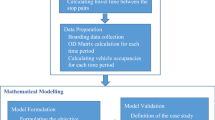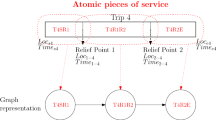Abstract
Rapid transit systems timetables are commonly designed to accommodate passenger demand in sections with the highest passenger load. However, disruptions frequently arise due to an increase in the demand, infrastructure incidences or as a consequence of fleet size reductions. All these circumstances give rise to unsupplied demand at certain stations, which generates passenger overloads in the available vehicles. The design of strategies that guarantee reasonable user waiting time with small increases of operation costs is now an important research topic. This paper proposes a tactical approach to determine optimal policies for dealing with such situations. Concretely, a short-turning strategy is analysed, where some vehicles perform short cycles in order to increase the frequency among certain stations of the lines and to equilibrate the train occupancy level. Turn-back points should be located and service offset should be determined with the objective of diminishing the passenger waiting time while preserving certain level of quality of service. Computational results and analysis for a real case study are provided.














Similar content being viewed by others
References
Abril, M., Barber, F., Ingolotti, L., Lova, A., Salido, M. A., & Tormos, P. (2004). An efficient method to schedule new trains on a heavily loaded railway network. In C. Lemaîitre, C. A. Reyes, & J. A. González (Eds.), Advances in Artificial Intelligence—IBERAMIA 2004 (Vol. 3315, pp. 164–173)., Lecture Notes in Computer Science Berlin Heidelberg: Springer.
Burdett, R. L., & Kozan, E. (2009). Techniques for inserting additional trains into existing timetables. Transportation Research Part B: Methodological, 43(8–9), 821–836.
Bussieck, M. R. (1998). Optimal lines in public rail transport. PhD thesis, Technische Universität Braunschweig, Germany.
Bussieck, M. R., Winter, T., & Zimmermann, U. T. (1997). Discrete optimization in public rail transport. Mathematical Programming, 79(1–3), 415–444.
Cacchiani, V., Caprara, A., & Toth, P. (2010a). Non-cyclic train timetabling and comparability graphs. Operations Research Letters, 38(3), 179–184.
Cacchiani, V., Caprara, A., & Toth, P. (2010b). Scheduling extra freight trains on railway networks. Transportation Research Part B: Methodological, 44(2), 215–231.
Cadarso, L., & Marín, A. (2012). Integration of timetable planning and rolling stock in rapid transit networks. Annals of Operations Research, 199(1), 113–135.
Canca, D. (2009). Operación mixta de una línea de ferrocarril. Análisis de capacidad y gestión de material rodante. Dirección y Organización, 39, 45–53.
Canca, D., Barrena, E., Algaba, E., & Zarzo, A. (2014). Design and analysis of demand-adapted railway timetables. Journal of Advanced Transportation, 48(2), 119–137.
Canca, D., Barrena, E., Zarzo, A., Ortega, F. A., & Algaba, E. (2012). Optimal train reallocation strategies under service disruptions. Procedia Social and Behavioral Sciences, 54, 402–413.
Ceder, A. (1989). Optimal design of transit short-turn trips. Transportation Research Record, 1221, 8–22.
Ceder, A., & Wilson, N. H. M. (1986). Bus network design. Transportation Research Part B: Methodological, 20(4), 331–334.
Chen, M., Liu, X., & Xia, J. (2005). Dynamic prediction method with schedule recovery impact for bus arrival time. Transportation Research Record, 1923, 208–217.
Chen, M., Niu, H. (2009). Modeling transit scheduling problem with short-turn strategy for a congested public bus line. In R. Liu, J. Zhang, and C. Guan, editors, Logistics: The Emerging Frontiers of Transportation and Development in China. Eighth International Conference of Chinese Logistics and Transportation Professionals (ICCLTP), pp. 4320–4326. American Society of Civil Engineers.
Chierici, A., Cordone, R., & Maja, R. (2004). The demand-dependent optimization of regular train timetables. Electronic Notes in Discrete Mathematics, 17, 99–104.
Coor, G. T. (1997). Analysis of the Short-Turning Strategy on High-Frequency Transit Lines. PhD thesis, Masschusetts Institute of Technology.
Corman, F., D’Ariano, A., Pacciarelli, D., & Pranzo, M. (2012). Bi-objective conflict detection and resolution in railway traffic management. Transportation Research Part C: Emerging Technologies, 20, 79–94.
Cortés, C. E., Jara-Díaz, S., & Tirachini, A. (2011). Integrating short turning and deadheading in the optimization of transit services. Transportation Research Part A: Policy and Practice, 45(5), 419–434.
D’Ariano, A., Pacciarelli, D., & Pranzo, M. (2007). A branch and bound algorithm for scheduling trains in a railway network. European Journal of Operational Research, 183(2), 643–657.
Delle Site, P. D., & Filippi, F. (1998). Service optimization for bus corridors with short-turn strategies and variable vehicle size. Transportation Research Part A: Policy and Practice, 32(1), 19–28.
Desaulniers, G., Hickman, M. (2007). Public transit. In C. Barnhart and G. Laporte, editors, Transportation, volume 14 of Handbooks in Operations Research and Management Science, chapter 2, pp. 69–127. Amsterdam: Elsevier.
Eberlein, X. J., Wilson, N. H. M., & Bernstein, D. (1999). Modeling real-time control strategies in public transport operations. In N. H. M. Wilson (Ed.), Computer-aided Transit Scheduling (Vol. 471, pp. 352–346), Lecture Notes in Economics and Mathematical Systems Springer: Berlin Heidelberg.
Eberlein, X. J., Wilson, N. H. M., Barnhart, C., & Bernstein, D. (1998). The real-time deadheading problem in transit operations control. Transportation Research Part B: Methodological, 32(2), 77–100.
Fischetti, M., Salvagnin, D., & Zanette, A. (2009). Fast approaches to improve the robustness of a railway timetable. Transportation Science, 43(3), 321–335.
Flier, H., Graffagnino, T., & Nunkesser, M. (2009). Scheduling additional trains on dense corridors. In J. Vahrenhold (Ed.), Experimental Algorithms (Vol. 5526, pp. 149–160)., Lecture Notes in Computer Science Springer: Berlin Heidelberg.
Fu, L., Liu, Q., & Calamai, P. (2003). Real-time optimization model for dynamic scheduling of transit operations. Transportation Research Record, 1857, 48–55.
Furth, P. G. (1987). Short turning on transit routes. Transportation Research Record, 1108, 42–52.
Grosfeld-Nir, A., & Bookbinder, J. H. (1995). The planning of headways in urban public transit. Annals of Operations Research, 60, 145–160.
Guihaire, V., & Hao, J. K. (2008). Transit network design and scheduling: A global review. Transportation Research Part A: Policy and Practice, 42(10), 1251–1273.
Hadas, Y., & Ceder, A. (2010). Optimal coordination of public-transit vehicles using operational tactics examined by simulation. Transportation Research Part C: Emerging Technologies, 18(6), 879–895.
Kroon, L. G., Dekker, R., & Vromans, M. (2007). Cyclic railway timetabling: a stochastic optimization approach. In F. Geraets, L. Kroon, A. Schöbel, D. Wagner, & C. D. Zaroliagis (Eds.), Algorithmic Methods for Railway Optimization (Vol. 4359, pp. 41–66)., Lecture Notes in Computer Science Berlin Heidelberg: Springer.
Liebchen, C. (2004). Symmetry for periodic railway timetables. Electronic Notes in Theoretical Computer Science, 92, 34–51.
Liebchen, C., & Möhring, R. (2002). A case study in periodic timetabling. Electronic Notes in Theoretical Computer Science, 66(6), 1–14.
Liebchen, C., & Möhring, R. (2007). The modeling power of the periodic event scheduling problem: railway timetables and beyond. In F. Geraets, L. G. Kroon, A. Schöbel, D. Wagner, & C. D. Zaroliagis (Eds.), Algorithmic Methods for Railway Optimization (Vol. 4359, pp. 3–40)., Lecture Notes in Computer Science Springer: Berlin Heidelberg.
Liebchen, C., & Peeters, L. (2009). Integral cycle bases for cyclic timetabling. Discrete Optimization, 6(1), 89–109.
Liebchen, C., & Stiller, S. (2009). Delay resistant timetabling. Public. Transport, 1(1), 55–72.
Louwerse, I., & Huisman, D. (2014). Adjusting a railway timetable in case of partial or complete blockades. European Journal of Operational Research, 235(3), 583–593.
Magnanti, T. L., & Wong, R. T. (1984). Network design and transportation planning: Models and algorithms. Transportation Science, 18(1), 1–55.
Mannino, C., & Mascis, A. (2009). Optimal real-time traffic control in metro stations. Operations Research, 57(4), 1026–1039.
Mesa, J. A., Ortega, F. A., & Pozo, M. A. (2009). Effective allocation of fleet frequencies by reducing intermediate stops and short turning in transit systems. In R. K. Ravindra K. Ahuja, R. H. Möhring, and C. D. Zaroliagis, (Ed.), Robust and Online Large-Scale Optimization (Vol. 5868, pp. 293–309)., Lecture Notes in Computer Science Springer: Berlin Heidelberg.
Mesa, J. A., Ortega, F. A., & Pozo, M. A. (2013). Locating optimal timetables and vehicle schedules in a transit line. Annals of Operations Research, 144(1), 263–285. doi:10.1007/s10479-013-1393-5 (published on line 25.
Michaelis, M., & Schöbel, A. (2009). Integrating line planning, timetabling, and vehicle scheduling: A customer-oriented heuristic. Public Transport, 1(3), 211–232.
Quak, C. B. (2003). Bus line planning. Master’s thesis, Delft University of technology, The Netherlands.
Serafini, P., & Ukovich, W. (1989). A mathematical model for periodic scheduling problems. SIAM Journal on Discrete Mathematics, 2(4), 550–581.
Soeldner, D.W. (1993). A Comparison of Control Options on the MBTA Green Line. PhD thesis, Massachusetts Institute of Technology.
Tirachini, A., Cortés, C.E. (2007). Disaggregated modeling of pre-planned short-turning strategies in transit corridors. In Transportation Research Board (TRB) 86th Annual Meeting, Washington DC., 21–25 Jan 2007.
Tirachini, A., Cortés, C. E., & Jara-Díaz, S. R. (2011). Optimal design and benefits of a short turning strategy for a bus corridor. Transportation, 38(1), 169–189.
Vera, V.A. (2010). Integrating Crew Scheduling and Rostering Problems. PhD thesis, Alma Mater Studiorum Università di Bologna, Italy.
Vijayaraghavan, T. A. S., & Anantharamaiah, K. (1995). Fleet assignment strategies in urban transportation using express and partial services. Transportation Research Part A: Policy and Practice, 29(2), 157–171.
Walker, C. G., Snowdonb, J. N., & Ryana, D. M. (2005). Simultaneous disruption recovery of a train timetable and crew roster in real time. Computers & Operations Research, 32(8), 2077–2094.
Wardman, M., Shires, J., Lythgoe, W., & Tyler, J. (2004). Consumer benefits and demand impacts of regular train timetables. International Journal of Transport Management, 2(1), 39–49.
Westerlund, T., & Pörn, R. (2002). Solving pseudo-convex mixed integer optimization problems by cutting plane techniques. Optimization and Engineering, 3(3), 253–280.
Wilson, N. H. M., Macchi, R. A., Fellows, R. E., & Deckoff, A. A. (1992). Improving service on the MBTA Green Line through better operations control. Transportation Research Record, 1361, 296–304.
Zhou, X., & Zhong, M. (2005). Bicriteria train scheduling for high-speed passenger railroad planning applications. European Journal of Operational Research, 167(3), 752–771.
Acknowledgments
This research work was partially supported by the Excellence program of the Andalusian Government, under grant P09-TEP-5022, and by the Natural Sciences and Engineering Research Council of Canada (NSERC) under grant 39682-10. We are also grateful to RENFE (Madrid commuter railway system operator) for providing data and information relevant to the calibration of the model. Thanks are due to the referees for their valuable comments.
Author information
Authors and Affiliations
Corresponding author
Rights and permissions
About this article
Cite this article
Canca, D., Barrena, E., Laporte, G. et al. A short-turning policy for the management of demand disruptions in rapid transit systems. Ann Oper Res 246, 145–166 (2016). https://doi.org/10.1007/s10479-014-1663-x
Published:
Issue Date:
DOI: https://doi.org/10.1007/s10479-014-1663-x




